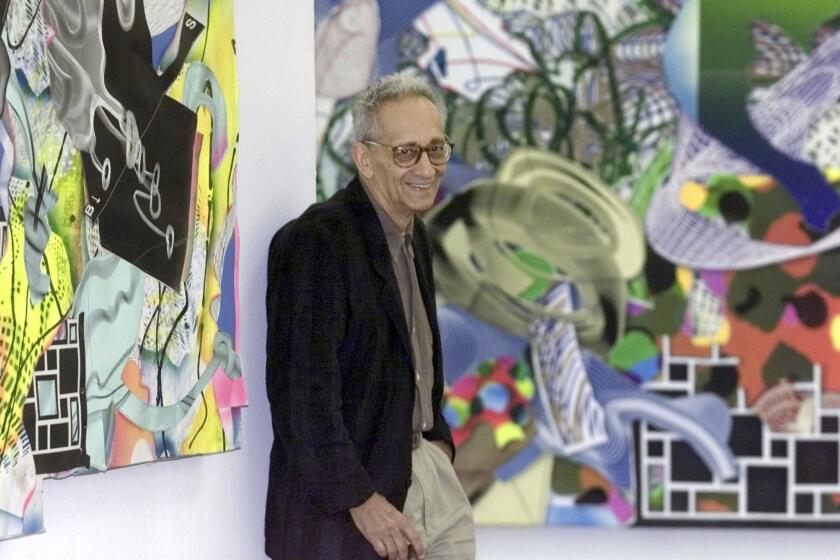STAGE : ACT Is Back on Course as S.F.’s Leading Theater
The more things change, the more they don’t necessarily stay the same. So it’s a good sign that the ceiling over his head keeps squeaking as Ed Hastings of the American Conservatory Theatre talks with a visitor from Los Angeles.
A ballet class is being held on the floor above, just as it was the last time the visitor spent a day at ACT nine years ago. A lot of things have happened to San Francisco’s leading theater since then. The most traumatic was the forced resignation of its founder, William Ball, in 1986, an unhappy memory for all.
But it’s still ACT. It still believes in the classics; it still supports a resident acting company; it still trains young actors.
“We take our vision from Bill,” says Hastings, Ball’s old lieutenant. “He’s very much a presence in the building.”
Not a physical presence, however. Ball hasn’t been back to Geary Street since his ouster. (He now works in Hollywood.) Hastings is on the bridge now, and he has brought the ship around. Subscriptions have shot up from 12,000 to 18,000 and this year’s single ticket sales are the best since Ball brought the company to San Francisco in 1967.
“A lot of that is inflation, though,” notes Hastings, never a man to overstate things, unless in order to make a point.
Towards the end, for example, Ball was giving his subscribers two-character plays acted in front of black drapes--all that the company could afford to do, he said. Hastings immediately put on a big-cast, big-budget “The Lady’s Not for Burning,” to bring back the old pizazz.
This year he’s giving ‘em “Diamond Lil” with Broadway musical-comedy star Gretchen Wyler in the Mae West role. This is San Francisco, after all.
But he is also giving them “King Lear,” with an old ACT reliable, Peter Donat. Also “The Immigrant,” written by and starring a more recent ACT regular, Mark Harelik. Also Odets’ “Golden Boy.” And a new adaptation of Aristophanes’ “The Birds.” And, of course, “A Christmas Carol.”
It’s called repertory, and some would say it’s what theater is all about. Available during my visit were “Diamond Lil” and Arthur Kopit’s “The End of the World with Symposium to Follow.” They made a nice contrast--a frivolous play and a responsible one.
No one has tried to revive “Diamond Lil” in a hundred years. Or at least since 1951, which was the last time Mae West did it. One reason is that Mae can’t be imitated, although everybody tries. Another reason is that her script is pure cardboard.
It’s surprisingly easy to lay aside these objections at the Geary. Gretchen Wyler may not be Mae West, but she is still Gretchen Wyler, a lady who knows how to take stage.
Rather than making Diamond Lil voluptuous, even kiddingly so, she makes her a cash-on-the-barrelhead dame who knows where all the bodies are buried, having disposed of half of them herself. You think of that great San Francisco madam, Sally Stanford.
True, it’s hard to believe Wyler when she tells us that she thought Donat was sending all those girls to Havana to become reading teachers. But we wouldn’t have believed Mae either. Wyler looks terrific and uncorks Mae’s great old wisecracks as if she wrote ‘em herself. That’s about all you can expect from “Diamond Lil.” We are not talking heavy drama here.
Kopit’s play isn’t drama at all. It tries to be, or seems to try; but that could be a subterfuge. Its message is that the real world is a lot more complicated than a play, and therefore can’t be solved like one.
Pirandello wrote to somewhat the same purpose. But Pirandello suggests that the real world can’t be solved at all. Kopit’s point is that one real-world problem has got to be solved: the question of nuclear arms. Leave that to the experts, and we may indeed be in for a Big Finish.
Kopit’s plot runs this way: A playwright (Mark Harelik) accepts a commission, as Kopit himself once did, to write a piece about the arms race. His first step is to fly down to Washington to see what the specialists say about it.
Rather than being “Dr. Strangelove” types, these turn out to be either reasonable men (Lawrence Hecht as a Pentagon general) or agreeable zanies (Rick Hamilton and Liam O’Brian as two think-tank strategists.) They tell him that the arms race is actually preventing nuclear war, which suggests that we ought to go on with it, until something untoward happens, which is fairly inevitable, given the laws of probability.
However, that’s outside the framework of their “model.” Within it, the tensions between the U.S. and the U.S.S.R. are ingeniously self-adjusting, an elegant mechanism that a man could watch for hours. And so far, the model has been reflected in the real world. Nobody has actually dropped a bomb on anybody.
The model, Hecht explains, enjoying the paradox, can accommodate an increase in tension. What’s dangerous is a decrease in tension. This confuses everybody. Hence, the fewer the weapons, the greater the chance of war.
Harelik is fascinated. It’s an Escher structure come to life, and we’re all living in it. How can he deal with that in a play? “End of the World” itself demonstrates the difficulty. Kopit keeps coming up with gimmicks to keep us listening: a running gag about Harelik’s being a private eye, for example.
But what we’re really listening for is ideas. The most unexpected comes up in Harelik’s troubled monologue about walking the floor with his first child. He comes to an open window. What if . . . ? It is not a temptation. It is not even a possibility. But what if . . . ?
Has any anti-war piece ever admitted that human beings are drawn to the idea of disaster--the romance, the drama, of it? At the same time there’s a confidence that such things don’t actually happen, not to us. Hence Kopit’s title. It’s not that hard to contemplate doomsday, when one is assured of a place at the symposium afterwards.
“Sure, I’m fiction,” Kopit’s play says to think-tank scenarios. “But so are you.” Laird Williamson’s production makes sure that this is said coolly. William Paterson gives a particularly canny performance as the rich old man who commissions the play. He seems to be on the side of the angels, but he could be working for Old Nick.
The visitor from Los Angeles immediately starts casting stars in the show. Vincent Price as the old man. Dustin Hoffman as the nervous playwright. Linda Hunt as his agent (a loving portrait of Kopit’s real agent, the late Audrey Wood). George C. Scott as the general--a nice bank shot against “Dr. Strangelove.” First we’ll do it at the Ahmanson, then we’ll tape it for HBO. Or maybe there’d be interest at Universal.
That’s the trouble with theater in Los Angeles. Up in San Francisco, they don’t need stars. These actors are family. William
Paterson, for example, has been playing Scrooge in “A Christmas Carol” as long as anybody can remember. Nobody cares about his TVQ. He’s only a very good actor.
Back in Hastings’ office, he and general manager John Sullivan sketch out some ideas for ACT’s future. A 300-seat space for new plays, now confined to a tiny stage called the Playroom. More collaboration with San Francisco artists like George Coates, with whom the company may do a piece next season. Perhaps another joint venture with the Los Angeles Theatre Center, after last season’s very successful “Ma Rainey’s Black Bottom.”
One flight up, speech teacher Bernard Vash puts his young actors through the St. Crispian’s day speech in Shakespeare’s “Henry V.” ’Release the back of the tongue more . . . make your long sounds really long and your short sounds really short . . . let the value of the sound work for you.”
Down the hall, ballet instructor John Loschmann puts his class to work at the barre. “Watch those arms. In the demi-plie, the arm rarely goes past the middle of the body. . . . When you turn out, lift!
“Feel that connection!”
Slide, squeak, thump. The sound of a theater back on course.
More to Read
The biggest entertainment stories
Get our big stories about Hollywood, film, television, music, arts, culture and more right in your inbox as soon as they publish.
You may occasionally receive promotional content from the Los Angeles Times.






